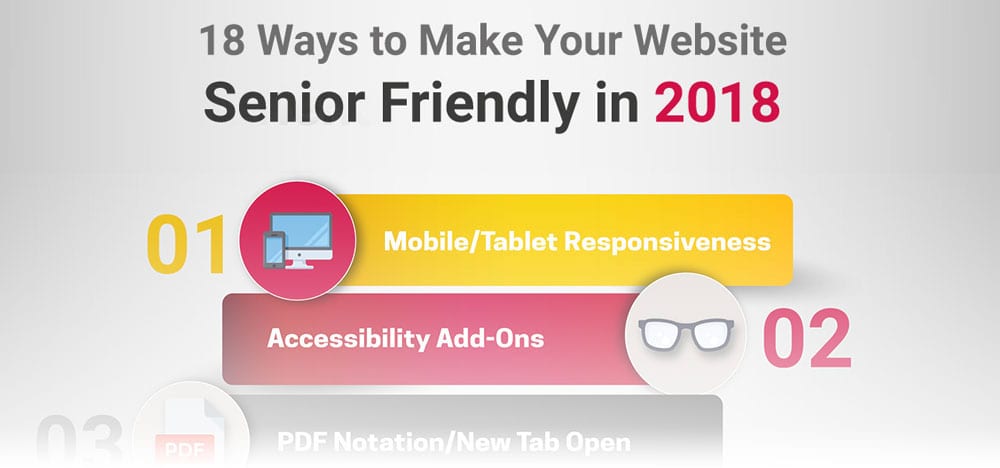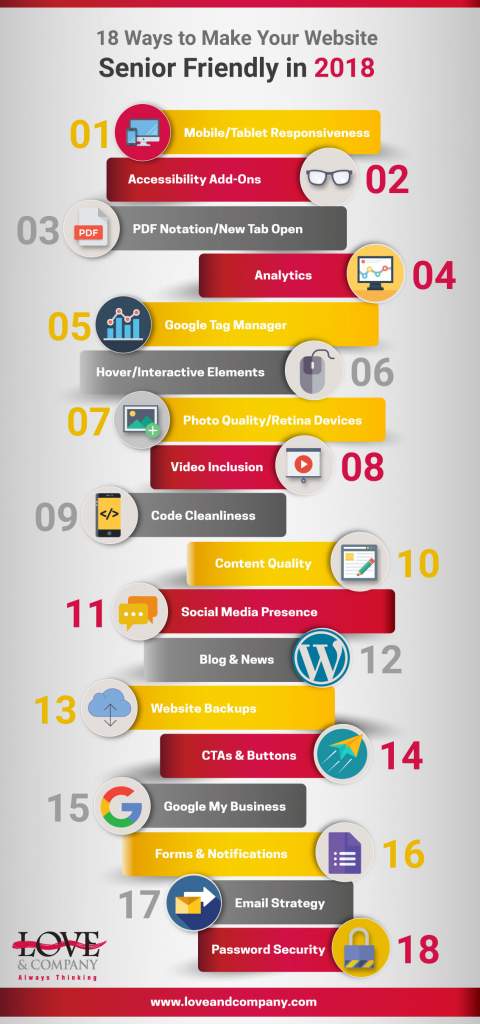By Clara Daly, Interactive Communications Director
Want to see the full infographic? Click the image to view.
2018 is here, and it’s time to review your digital strategies and website to make sure your digital presence is up to date. Here are 18 areas you should review as you begin the new year.
1.) Responsiveness
Today, almost half of older adults with cellphones own smartphones, so ensuring your website can easily display and transition between any type of device is critical to getting your information to your target audience. To appeal to adult children, a responsive website becomes even more critical.
2.) Accessibility items
There are a lot of accessibility options, from plugins that help highlight links, increase text size and contrast, to those that enable the use of ‘alt tags’ on photos (hidden captions that help individuals who may be using screen readers). Simple add-ons, which may not be utilized by many of your prospects, will make a world of difference to those who do need accessibility assistance when browsing the web.
3.) PDF notation
While many browsers are much better about displaying PDFs inline, you should always note when a link or button links to a PDF file. Additionally, ensure the file opens in a new window or tab to reduce accidental bounces off your website and keep prospects navigating your information.
4.) Analytics
Although you can use any service you prefer, Google Analytics is the most-used analytics software across websites right now. Many companies choose to use Google Analytics because it’s free and allows you to gather valuable data regarding who is visiting your site. The data enables you to learn more about your site, such as which pages may be performing poorly and need some tweaking, and what search terms people are using to find your site. This data can help inform blog and social content posts, helping you better plan your content marketing to improve SEO, and build a relationship with your prospects.
5.) Google Tag Manager
Google Tag Manager (GTM) is another aspect of Google Analytics that is a great way to “install” additional tracking software in a lightweight and easy to update method. When properly set up, you can use a single Tag Manager script to insert things like heat mapping tracking, Facebook pixels, and other cookies that help you monitor and gather data about how prospects are using your site.
6.) Hover/interactive elements
Hover-triggered interactive elements used to be a huge trend, but their popularity is rapidly fading, as they are not easy to navigate on mobile devices. The more hurdles you put in the way, the less chance there is your visitor will end up at the bottom of your funnel.
7.) Photo quality/retina devices
Walls of dense text are out, and videos and photography (supplemented by quality – but not necessarily lengthy – copy) are in. As devices become higher resolution with deeper pixel density, your photos need to be up to snuff. The average user spends less than 3 seconds determining if they want to navigate deeper into a website, and responsive, high-quality, professional design that displays well is critical to your brand’s first impressions.
8.) Video inclusion
Google owns YouTube and gives high priority to videos on a YouTube channel that has lots of inbound links (from websites, blogs, etc.). Video production can be a little costly upfront, but the return on views and conversions can be an invaluable part of your overall digital marketing plan. Snippets of existing videos and B-roll footage can also be used to create short digital ads or extra content for blogs.
9.) Code cleanliness (outdated old code, WC3 compliance, flash, etc.)
Coding marches on, with CSS and even HTML becoming rapidly outdated as the years go on. Check your site for W3C compliance, ensure you aren’t excessively relying on iframes or Flash-based elements, and design with tables. If your site is in need of an update, it’s likely going to be more effective in the long run to create a fresh build with current technology supporting the structure.
10.) Content quality/length
Writing digital content is a far cry from writing for print. While studies and our own metrics show that individuals will engage and read large blocks of text once they feel the content is valuable, you first have to get them to buy into the value of your content. Utilizing lists and bullets is a great way to visually break up text for the web, allowing users to quickly scan the content and determine the value. Keep headlines short with paragraphs not exceeding 5-6 sentences. Always start with keyword research for SEO, and write valuable content that people are searching for.
11.) Social links/social upkeep (plus data quality)
Ensure you’re driving people to your social channels whenever possible, whether it’s in the footer or header of your website, in your e-newsletters, or within your blog itself. Adding share buttons is a great way to help organic traffic spread your content. This sort of traffic and interest is known as ‘earned’ media, and it helps build a rapport with your prospects. Come up with a social posting schedule, or engage an agency to come up with one for you. Social upkeep is equally as important as simply having social channels, and if not regularly updated, stale content may actually end up hurting instead of helping.
12.) Blog/news upkeep
Blogs can be the workhorse of your SEO and a place for fresh, educational content. It’s unlikely you’re updating your actual website pages on a weekly or even monthly basis, but using a blog space to post regularly is a great way to keep people returning to your site (and help search engines view your website as current, placing your site higher on the search engine results page). Blogs are also a great spot to dive deep into focused, detailed information on one particular subject (floor plans, dining, staff bios) that are otherwise inappropriate for main pages on the website due to content length.
13.) Website backups
Are you regularly backing up your website? Everything from the database to the photos and images should be regularly backed up (at least once a month for the full site and weekly to biweekly for the database). There are multiple cloud storage solutions available, and depending on your hosting or other security software, automated backups can be an easy set-it-and-forget-it method, only needing to be retrieved if there’s ever an issue with your site. Think of it as insurance. If your site is strong, secure and well built, the likelihood of needing to utilize a backup is low, but it’s certainly worth having in place in case you ever need it.
14.) CTAs & buttons
One of the biggest issues I regularly see with older websites is the lack of appropriate calls-to-action (CTAs). You should always have a clear next step for a prospect when they’re on your website. CTAs could include filling out a form, signing up for your e-newsletter, or a button that takes them to another page that nurtures them deeper down the sales funnel.
15.) Google My Business
Claiming your Google My Business listing is critical to how you show up on the SERP (search engine results page.) That little box that you see on the right-hand side of the screen when you search for a business is a direct result of the Google My Business listing. There, you can map your location, add photos, gather (and monitor) reviews, add business hours, and more. It’s a simple, free, and effective way to get your community’s information on Google.
16.) Forms
When creating forms, be sure to build two automatic emails – one that goes to the prospect with a deliverable, and one to the sales or marketing team member. Team members should also receive appropriate sales training on how to work digital leads, as they differ greatly from leads that call to set up an appointment. Ensuring your forms are properly responding to prospect requests and notifying your team is critical to working your digital leads.
17.) Email strategy
Do you have an email marketing strategy? Is it a regularly planned, scheduled calendar or are emails only occasionally sent out? Are the emails CAN-SPAM compliant, and have the people on your list opted-in to receive digital marketing content from you? Email campaigns – everything from nurturing drip series to regular e-newsletters – can be a workhorse to keep leads interested in your community and keep your brand top-of-mind, but there’s a lot of strategy (and legality) that goes into making email marketing campaigns effective.
18.) Password security
Doesn’t it seem like every time you sign up for an account on a website, the password requirements are becoming more and more rigorous? That’s because bots and hackers are becoming more sophisticated. A simple news search on ‘data breach’ results in stories about large retailers becoming victims of hackers, and being more vulnerable over the last few years to cyber attacks. There’s no time like the present to revisit the logins to your website and social sites, and create new, stronger passwords. If you’re stuck, you can use one of many online generators to help create a new, more secure password.
Curious how your digital presence stacks up? Click here for a free digital assessment, or view our infographic!






